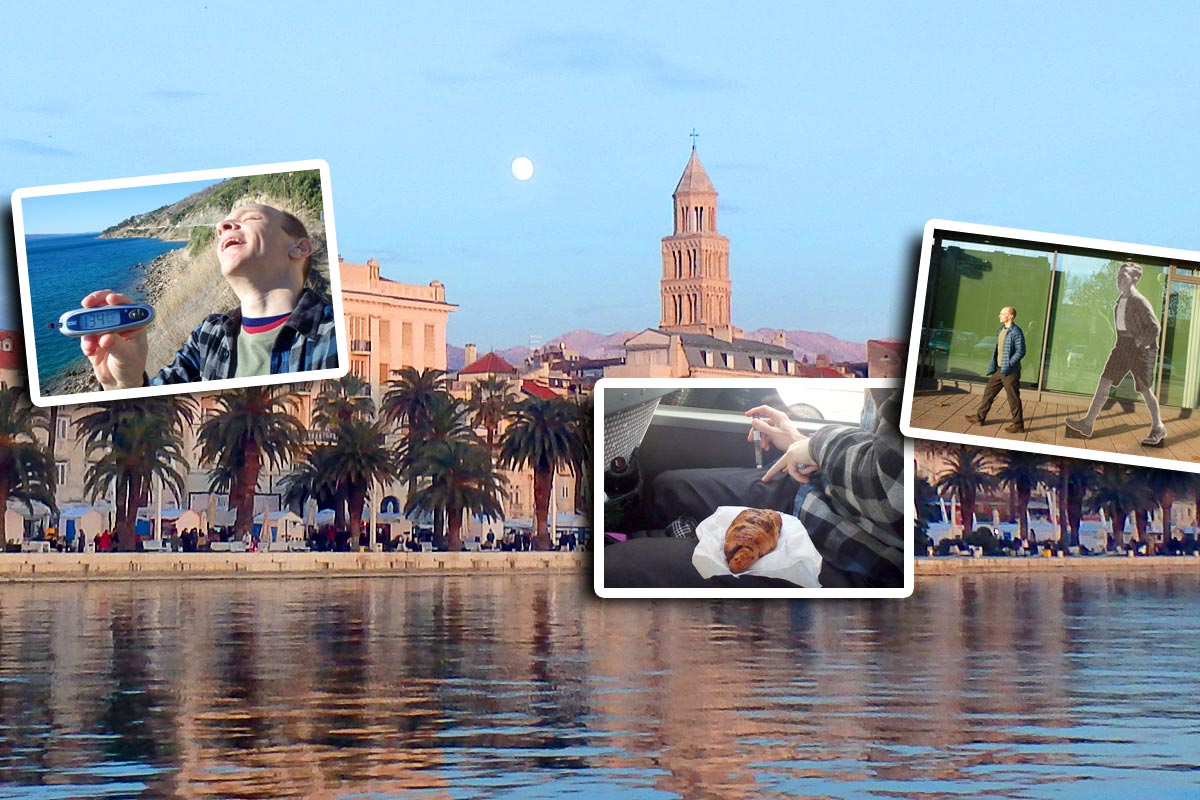
Croatia is a land of beautiful red-roofed communities dotting the sunny Adriatic Sea and cooler, mountainous landscapes further inland. Traveling to Croatia with diabetes isn’t difficult, if you know what to plan for and train your mind to avoid unfounded fears.
In this guide to traveling to Croatia with diabetes, you’ll find helpful tips about getting around Croatia as a diabetic, and info about what kinds of real foods and experiences you’ll have to deal with that you won’t find in traditional travel guides.
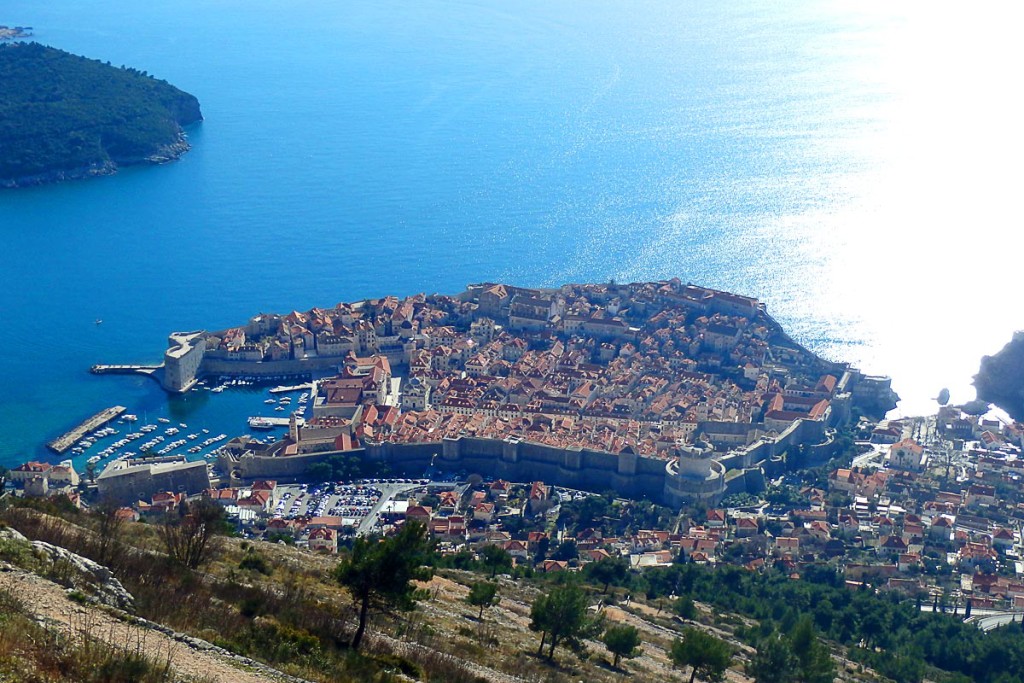
Dubrovnik as seen from Mt. Srđ.
On this page you’ll find:
- Foods you’ll encounter in Croatia, and how to dose for them
- Communicating with Croatians about diabetes, including medical personnel
- How to carry diabetes supplies while in Croatia
- Details about the experiences of a Type 1 diabetic (me) who visited Croatia
- Inspiration (for anyone still deciding whether or not to go to Croatia)
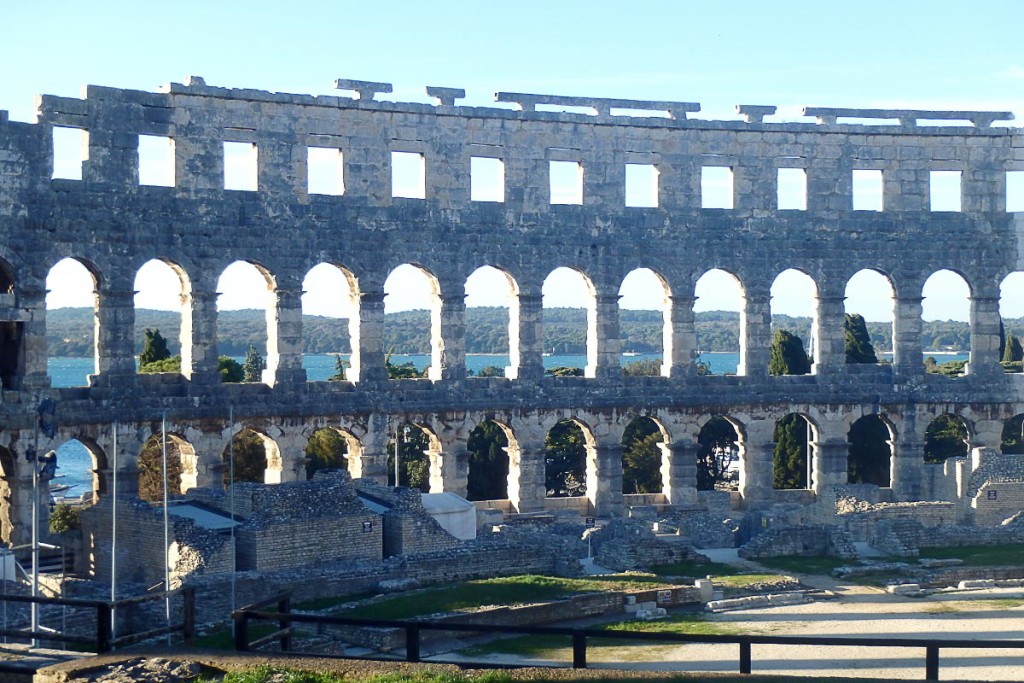
Old Roman amphitheater in Pula.
Diabetes in Croatia
Croatia was part of the former Yugoslavia and is now its own country. With a heavy tourism industry, Croatia has plenty of money and all the usual first-world amenities you’d expect of a modern nation.
For diabetics traveling to Croatia, this means pharmacies will have insulin – even if they don’t have your exact kind, they’ll at least have something very similar – and that any doctors or nurses you need to speak to will be good and familiar with diabetes.
But none of this should matter to you (see below)!
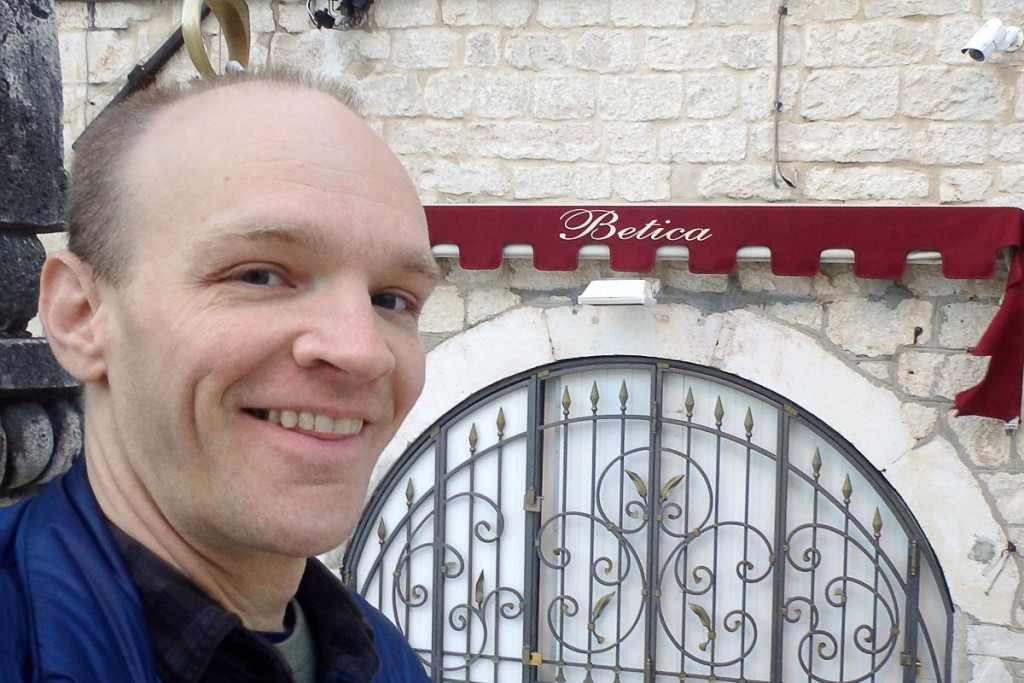
I don’t know what Betica sells but it’s my favorite shop in Croatia for obvious reasons.
How to speak Croatian – for T1Ds
“Diabetes mellitus” in Croatian is šećerna bolest, pronounced “sheh chair na ball est”. However, at least as popular is the English term diabetes, so you really don’t need to worry about the Croatian version unless you just enjoy languages.
There are two other points to keep in mind when traveling in Croatia as a diabetic when it comes to communication, though:

Sunset and sliver moon in Zagreb.
- It is very unlikely you will need to speak to anyone about diabetes. Emergencies are so rare, and you’ll be so prepared, that you really don’t need to worry about it. Even in a worst-case scenario, you can just say “diabetes” in English (try pronouncing it “dee a bet ess”) and/or show off a blood sugar meter or insulin pen, and they’ll understand. And if they don’t…
- You should be wearing some jewelry (bracelet, necklace, et cetera) that says “diabetes” or “Type 1 diabetes” on it. Alternatively, some diabetics carry a card in their pocket saying they’re diabetic. Actually having to use a piece of jewelry or a card to tell someone you’re diabetic is just as unlikely as having to vocalize “diabetes”, but it’s a little emotional insurance if nothing else.
This brings us to the most important part of this guide.
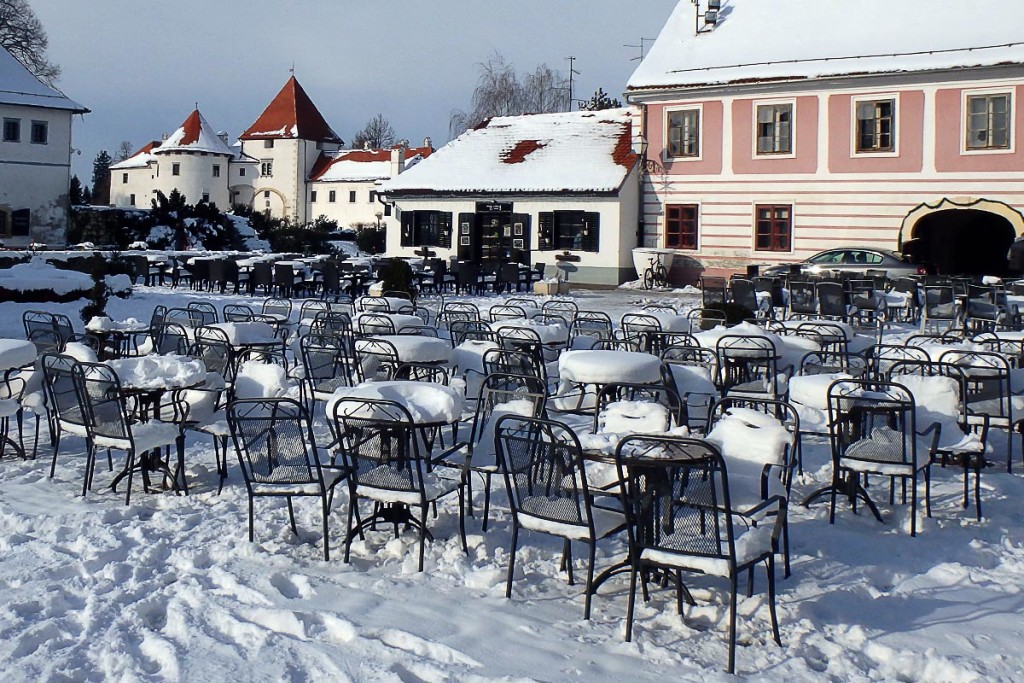
Chilly outdoor café in Varaždin.
The two most important points to traveling in Croatia with diabetes
Take care of the following two things and there will be nothing you can’t do in Croatia (or anywhere else)!
1. Get the right attitude
Most diabetics have some fears when they’re thinking of traveling. All of these fears are all in your head: traveling with diabetes is not that much different from having diabetes at home in your “regular” life.
Getting over these fears is necessary for smooth and enjoyable travel. And all you need to do is adopt the right attitude, which is: Nothing bad will happen to you while traveling in Croatia!
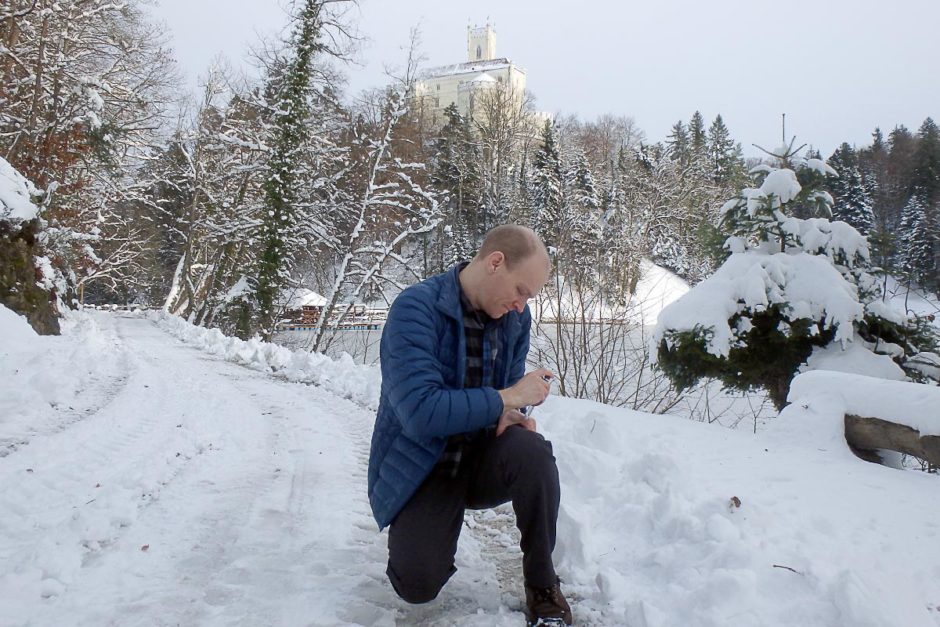
Snow shot outside Trakošćan Castle.
Internalize that thought. Memorize it. Let it seep into all parts of your brain. Because it’s true. As long as you are conscientious – pay attention to what you’re eating, do your best with insulin doses, take into account your exercise/sleep/alcohol levels and times, and check your blood sugar often – you’ll be fine.
2. Be prepared
The smallest amount of simple preparation is necessary when traveling Croatia as a diabetic, and anyway will help relax you and achieve the right attitude as just discussed.
My advice is to calculate how much insulin, testing supplies, and whatever else you’ll need, then bring double that. Break everything up into at least two bags (say, a main suitcase plus a day pack) in case something happens to one. (It won’t, but just in case.)
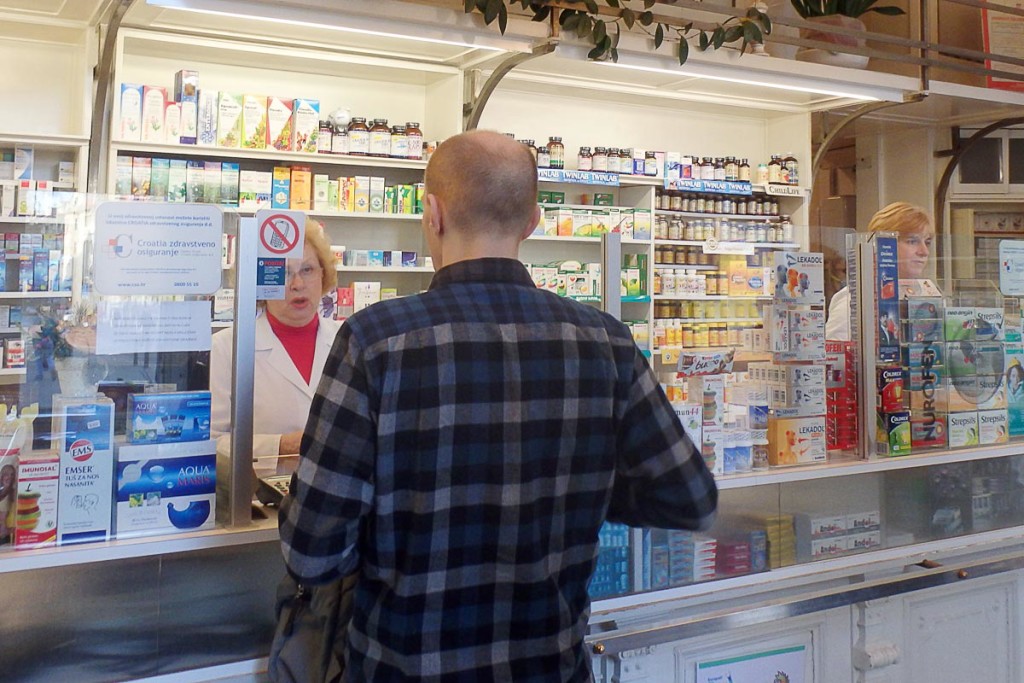
Trying to convince a pharmacist to sell me stuff without a prescription.
The other side of that, of course, is food: make sure you always have enough low blood sugar snacks with you. Convenience stores and small shops are everywhere, especially near train and bus stations. Stock up on juice and cookies, or whatever you prefer, when you can.
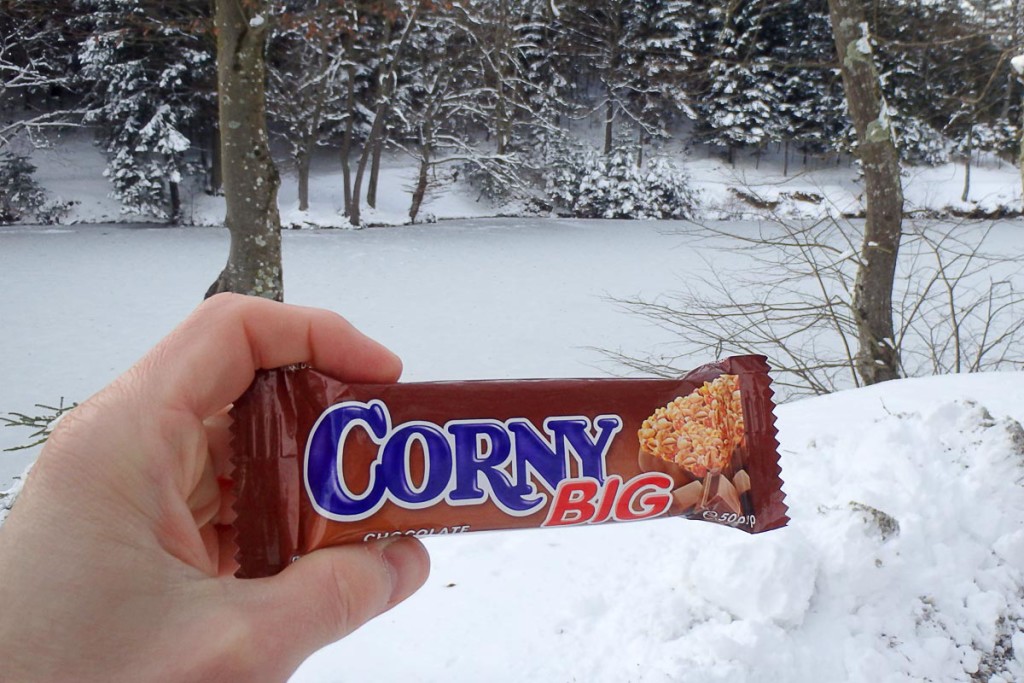
Low blood sugar snack: Corny Big!
If you’re walking around some town, or taking a bus or train on a long journey, there may be nothing to buy on board and there may be no chance to stop on the way. Buy enough beforehand. This includes low BG snacks but also lunch or dinner. Don’t get caught without food!
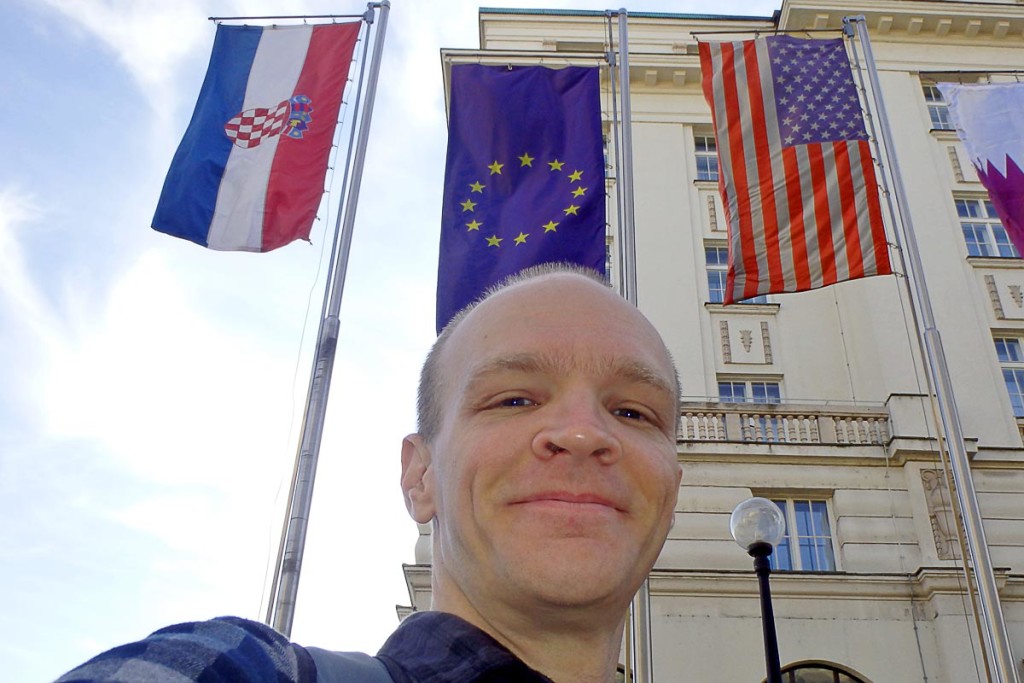
My experiences in Croatia with Type 1 diabetes
On a longer European backpacking trip, I visited Croatia twice: first for 15 days, then for another five days a month later.
With my (non-diabetic) partner Masayo, I went to the capital Zagreb by bus from Slovenia. Spending Christmas there, we then went to Osijek and toured the buildings of Tvrđa, the Old Town section of Osijek still pockmarked with bullets from the War of Independence in the early 1990s.
We headed into the snowy northern mountains and the town of Varaždin and found a bus to the obscure and striking Trakošćan Castle.
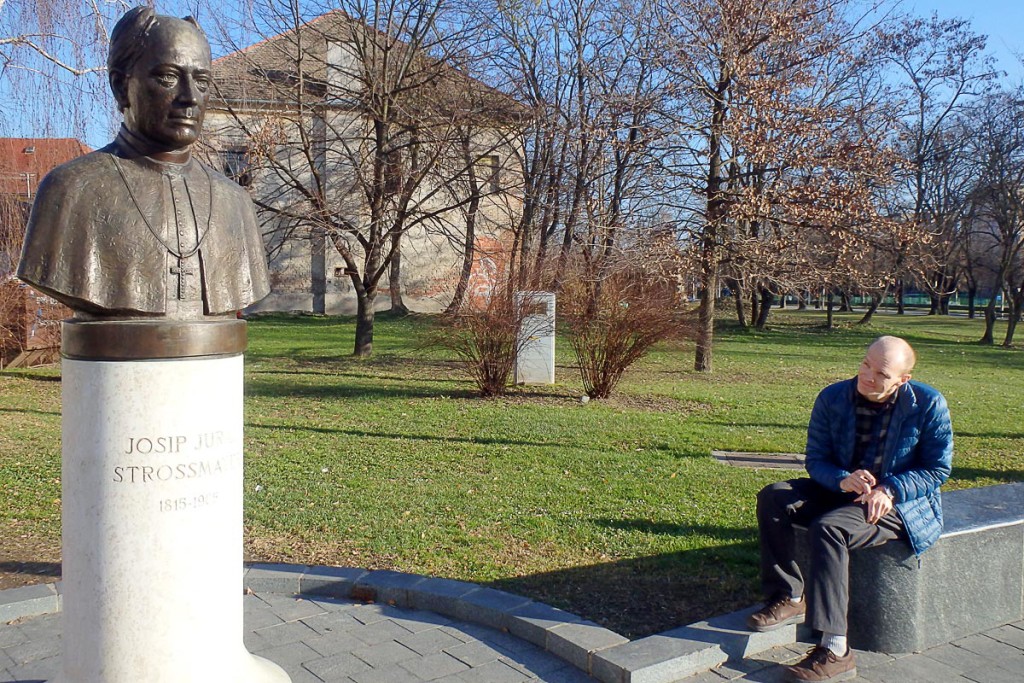
Humalog shot with a new friend.
We spent New Year’s on the Adriatic Sea in Pula on the Istrian Peninsula, and then took a bus all the way down the beautiful coast to historic Split, from where we also visited the town of Trogir and its ancient fortress. In Split we rented a car and drove to the colored lakes of Imotski near the border with Bosnia and Herzegovina.
After seeing a few other countries, about a month later we entered Croatia again to see Dubrovnik in the far south after crossing the border from Montenegro by bus. After five days in amazing Dubrovnik we flew to Norway.
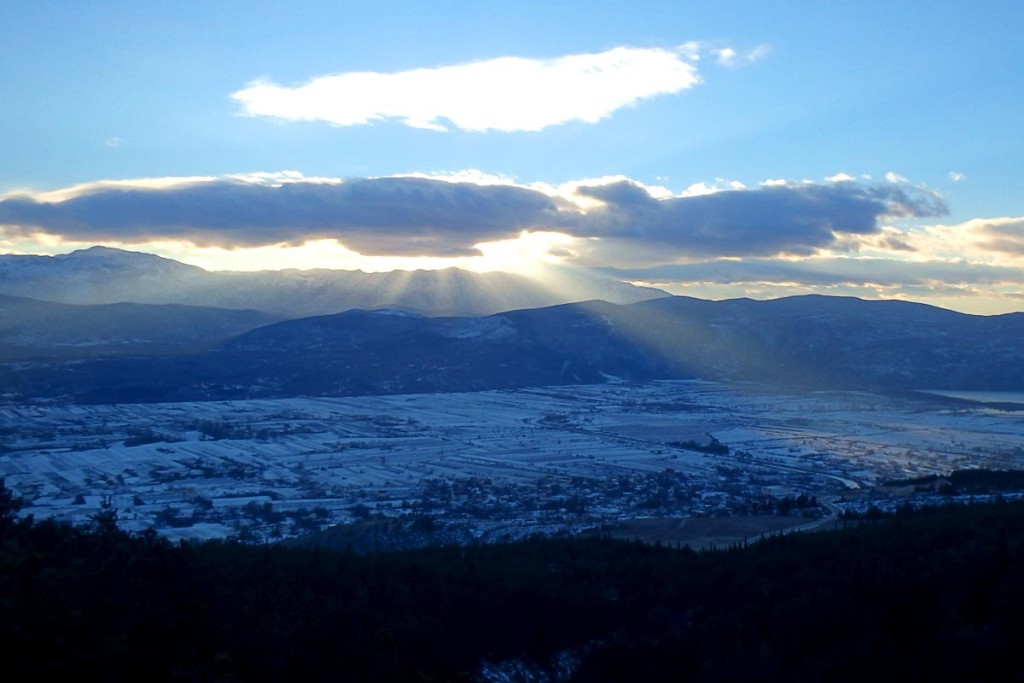
My blood sugar stats in Croatia
Eating whatever I wanted – and being a budget traveler meant I was eating junk food as well as regular restaurant food – my blood sugars in Croatia were better than they could have been, but worse than they should have been.
- Total number of BG checks: 78
- Average BG: 171
- Lowest BG: 48
- Highest BG: 422
- Average morning BGs (~12:00): 156
- Average afternoon BGs (12:00~6:00): 160
- Average evening BGs (6:00~): 201
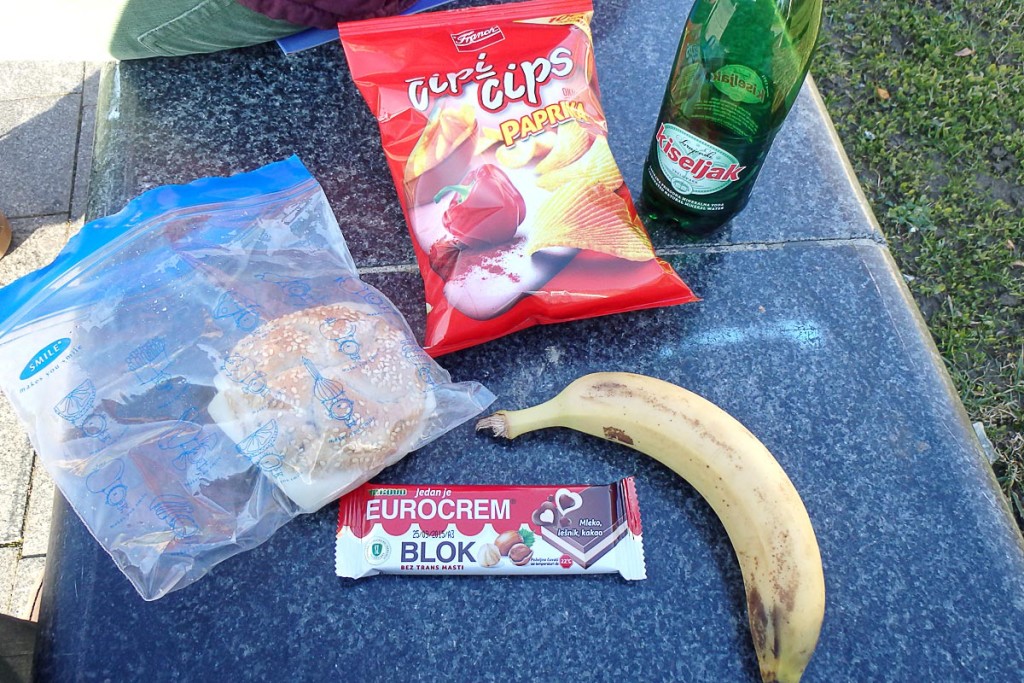
Banana and sandwich swiped from the breakfast buffet, plus chips and chocolate from a store. Nice for a picnic lunch.
This was better than my average for the previous country, Slovenia. Still too high at night after dinner, though my average was skewed by that shocking 422 (last reading on New Year’s Eve, no less!).
For your blood sugar checks in Croatia, as long as you’re checking often and doing your best to make adjustments, you’re doing the right thing and enabling your travel experience. Don’t get down about bad readings (well, the 422 might bring you down a little!). Just keep working at it.
But don’t let diabetes dictate everything about your trip. Work with diabetes, not against it, and not for it.
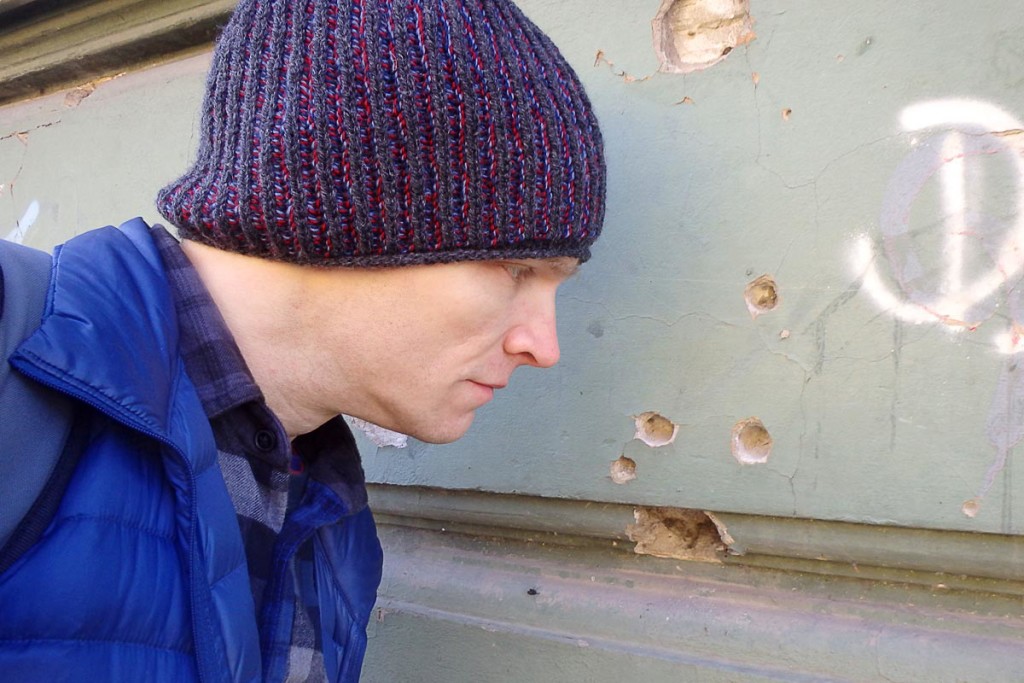
Bullet holes still on buildings in Osijek.
Food vs. insulin in Croatia
Croatia is full of delicious seafood, especially on the coast, but international restaurants and cafés and convenience store food may also make up your Croatian dining experiences.
As with much restaurant food, pasta and potatoes and rice can be quite high in carbs, as can even thin-looking sauces. The food listed here is what I found in Croatia, and will likely mirror to a considerable degree your own choices while traveling there:
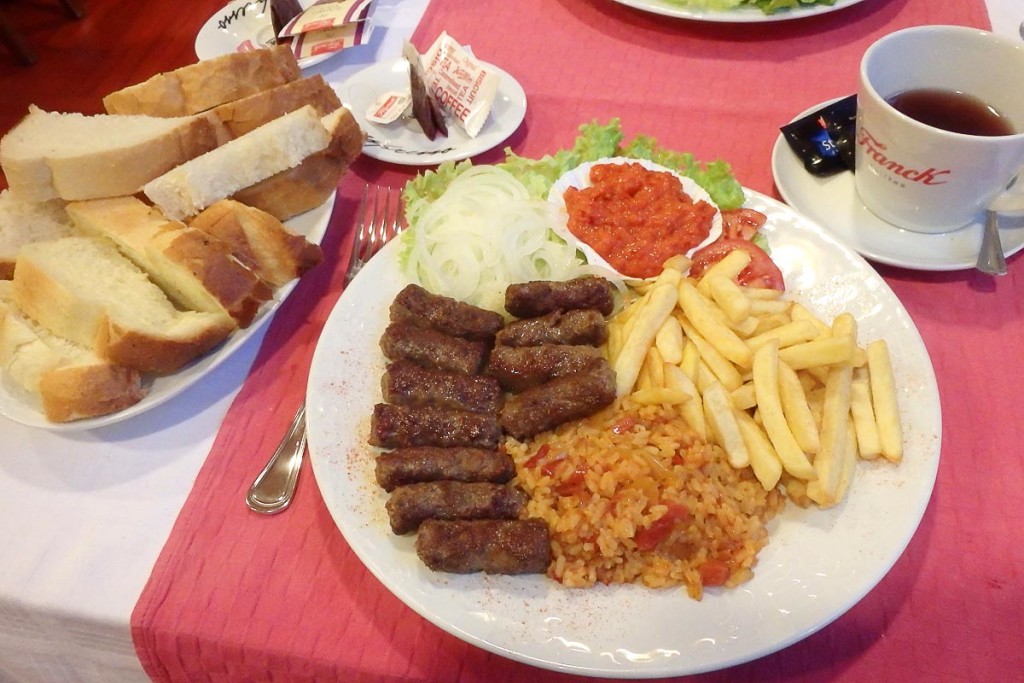
Bread AND potatoes AND rice. Good luck, insulin.
- Restaurant dishes – Can feature rice, noodles, potatoes, bread, or some combination thereof, as well as the main dish of fish or meat or whatever else you’d like. The sausages are delicious, but beware of carbs lurking more densely than you might imagine in restaurant meals. Dose your insulin heartily, but check soon afterwards once or twice to see how you’re doing.
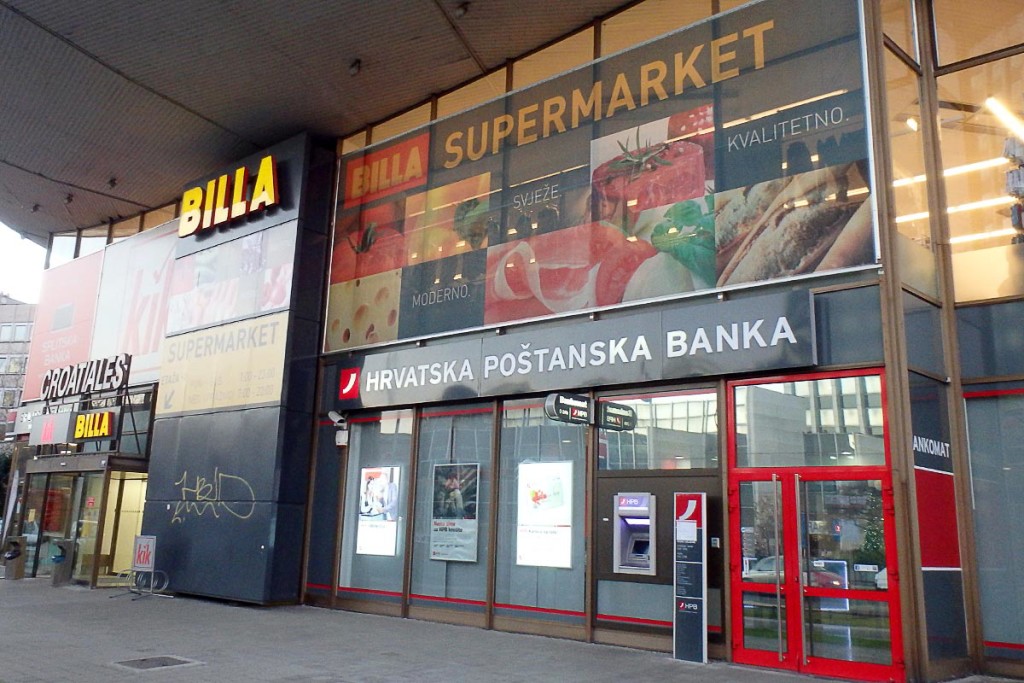
- Supermarket food – Renting local apartments for a couple of days (see below) can be pretty cost-effective in Croatia, and you may have a full kitchen to play with. (This may be true at hostels, too.) There are large and small Croatian supermarkets where you can find things you need for a big, balanced meal if you feel like cooking. Good way to take control of what you eat and quite possibly be very accurate about carbs.
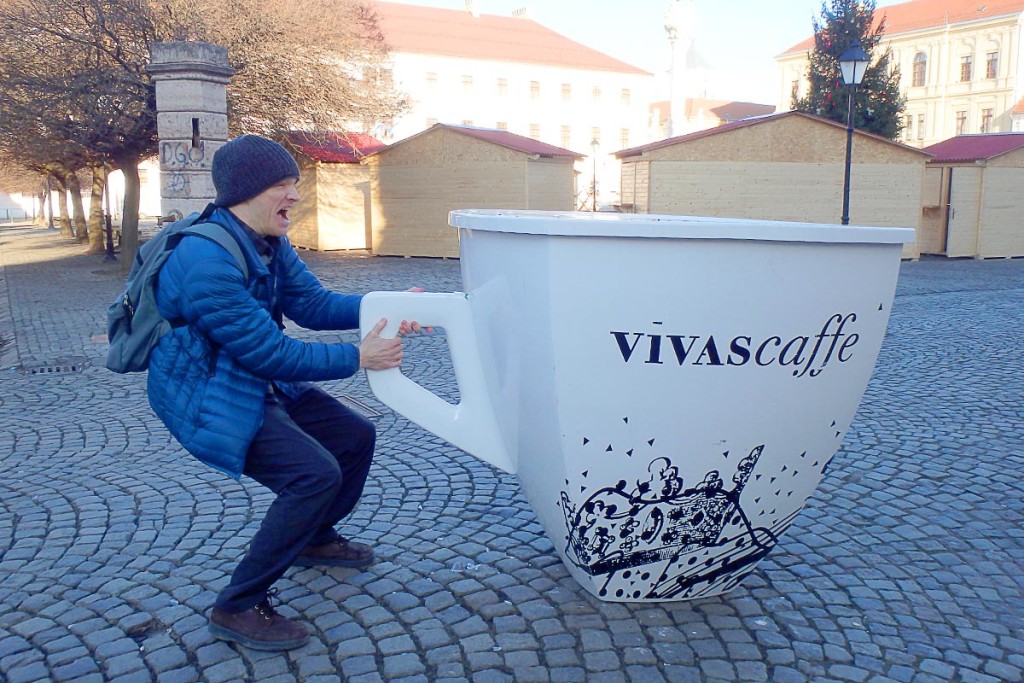
- Coffee shops – The usual gaggle of coffee shops are found around Croatia. Full of cakes and pastries and doughnuts, sometimes they also serve simple pasta or sandwich dishes. High in carbs, generally speaking. But a great place to sit and relax, especially at the many outdoor cafés you’ll come across.
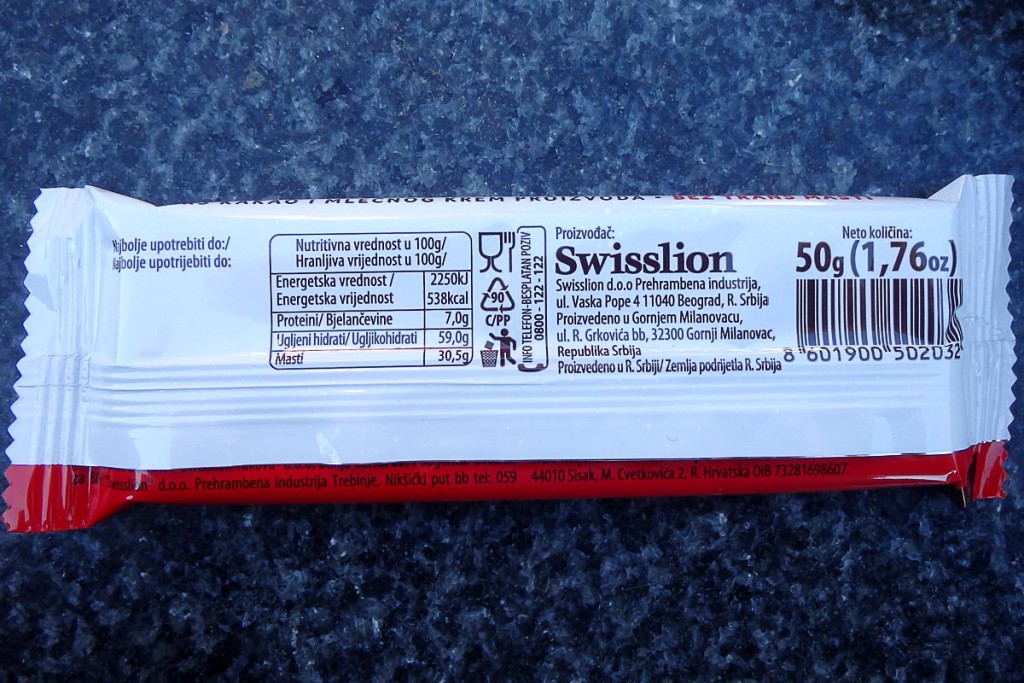
Candy bar with carbohydrate info in two languages – ugljeni hidrati (Bosnian) and ugljikohidrati (Croatian).
- Breakfast buffets – If you’re not cooking for yourself or trying a café, you might enjoy a big buffet breakfast included with your room. These generally feature lunch meats and cheeses plus bread, eggs, yogurt, and fruit. The best ones will allow you to stuff yourself and save money by eating a light lunch. But if you’re like many diabetics who have trouble with high blood sugars in the morning, be careful. Depending on your sleep schedule, you might need quite a big shot for a large breakfast. Experiment and check often.
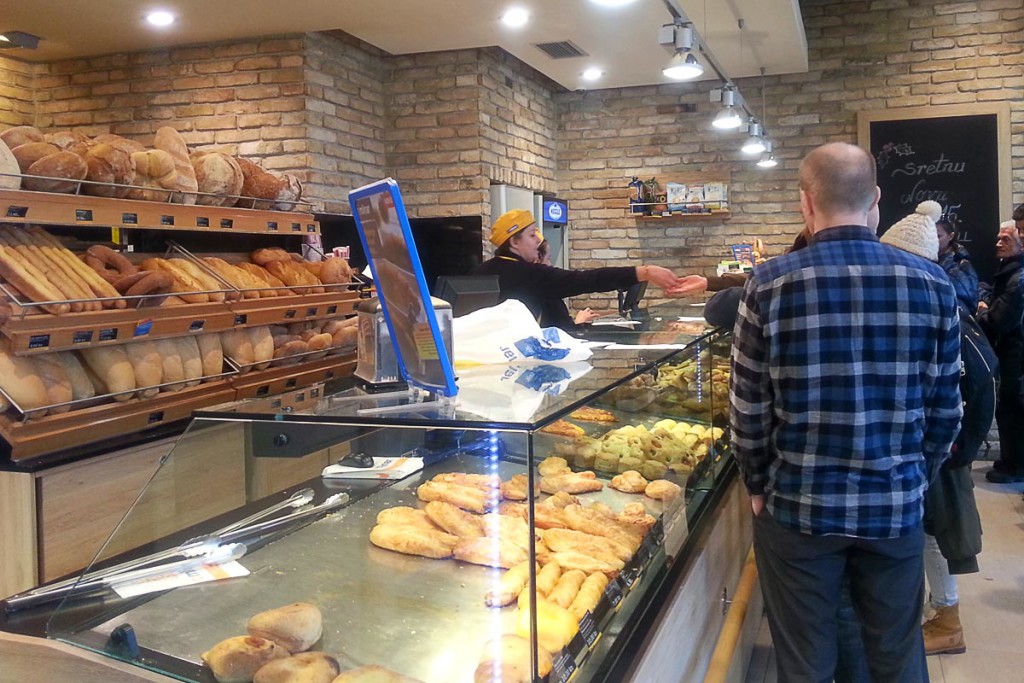
Mlinar bakery at a bus stop on the Adriatic coast.
- Bus and train food – As mentioned above, stock up on lunch before boarding a bus or train since if may be your last chance. Bakeries like the Mlinar chain, plus regular grocery stores and kiosks, are usually easy to find around stations. Enjoy that meal as you watch the Croatian scenery drift by!
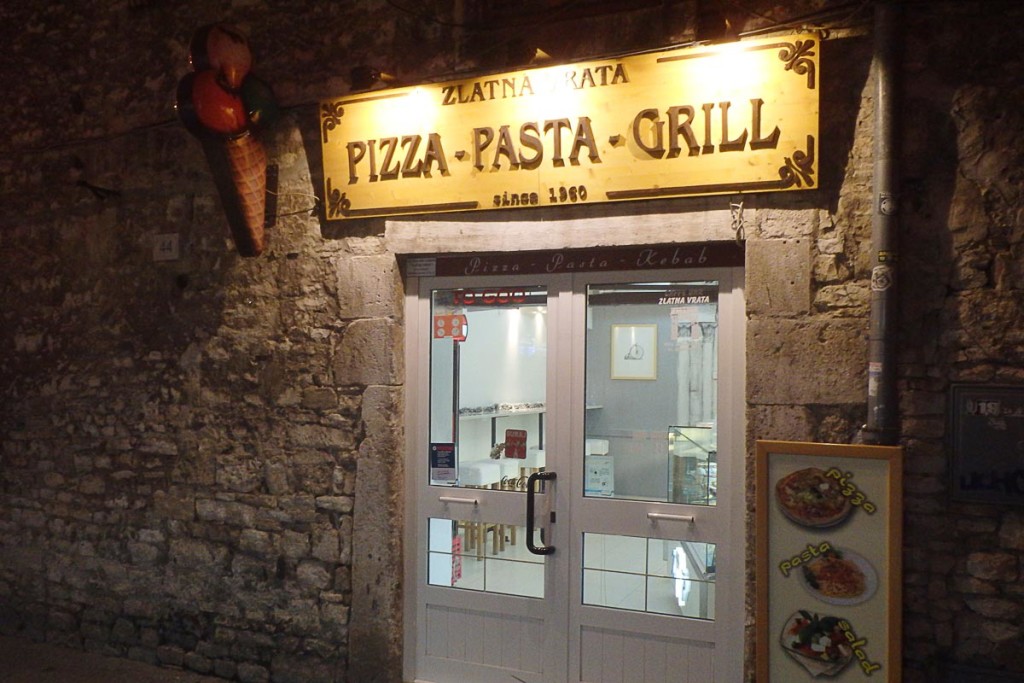
- Pizza ‘n’ burgers – Western places like McDonald’s are usually not too far away, and lots of little shops sell good takeout pizzas. Pizzas and strange thick burgers can be high in carbs, as can the potato chips and beers that some unfortunate diabetics (like me) tend to pair them with. You can handle it, just dose wisely and check afterwards. Just like at home.
Taking insulin in public in Croatia
Taking a shot, or checking your blood sugar, in public is generally ok but I’d suggest being very discreet, simply because some people might not enjoy seeing it. (People get squeamish. Forgive them.)
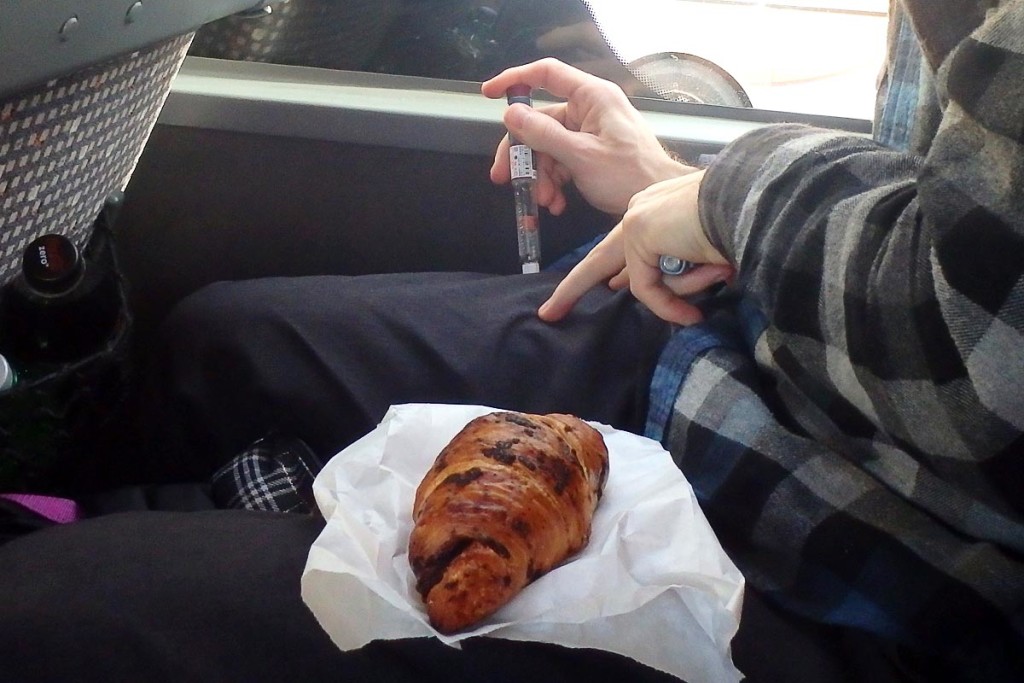
Shot on a bus.
I always took my shots in one of my legs – through my pants – at restaurant tables or in my seat on a train or bus. You can do it this way if you think you can get away with it, but of course you can always go take care of everything in the nearest bathroom.
Accommodation in Croatia
You can find high-end hotels and resorts in Croatia, dirt-cheap dorm beds, and everything in between. Guesthouses and even by-the-day apartments can offer the best value, but your budget will dictate where you stay.
I used booking.com for all my rooms in Croatia, and it was nice because I could choose the location, the price, and extras (free breakfast was always a plus). However you book your rooms, the places I stayed may give you an overview of what you can expect:
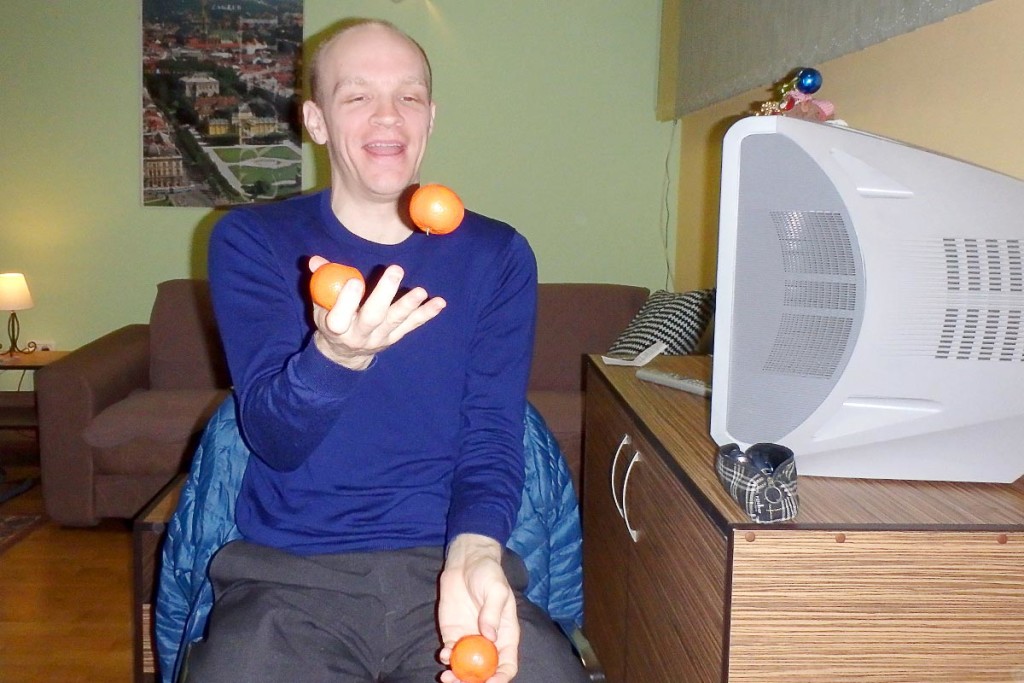
Apartman Lilly is big enough for me to practice my tangerine juggling.
- Apartman Lilly, Zagreb – This is a residential apartment building. A nice wide space with a full kitchen and a laundry machine. It was easy to walk the 1-2 kilometers to the happening parts of Zagreb from here, and there is a tram stop and a big supermarket right outside the door.
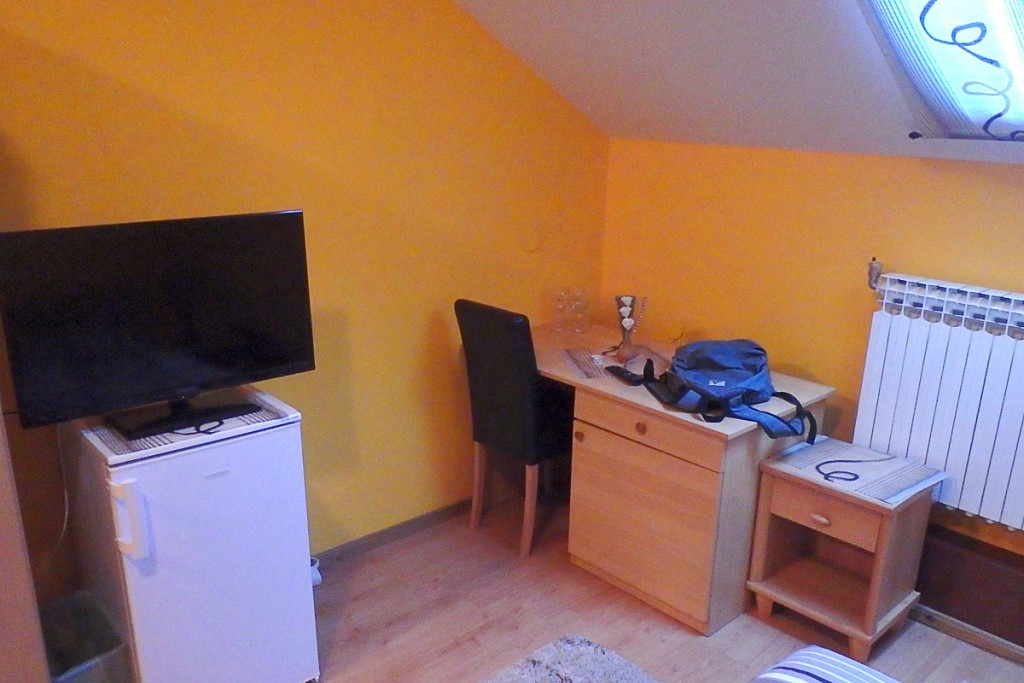
Sobe Lišnić, with refrigerator for insulin.
- Sobe Lišnić, Osijek – A cute little hotel right near the heart of Osijek (which is small anyway). Sobe Lišnić had a nice breakfast buffet and small but clean and quiet room. Only a skylight window, so no view.
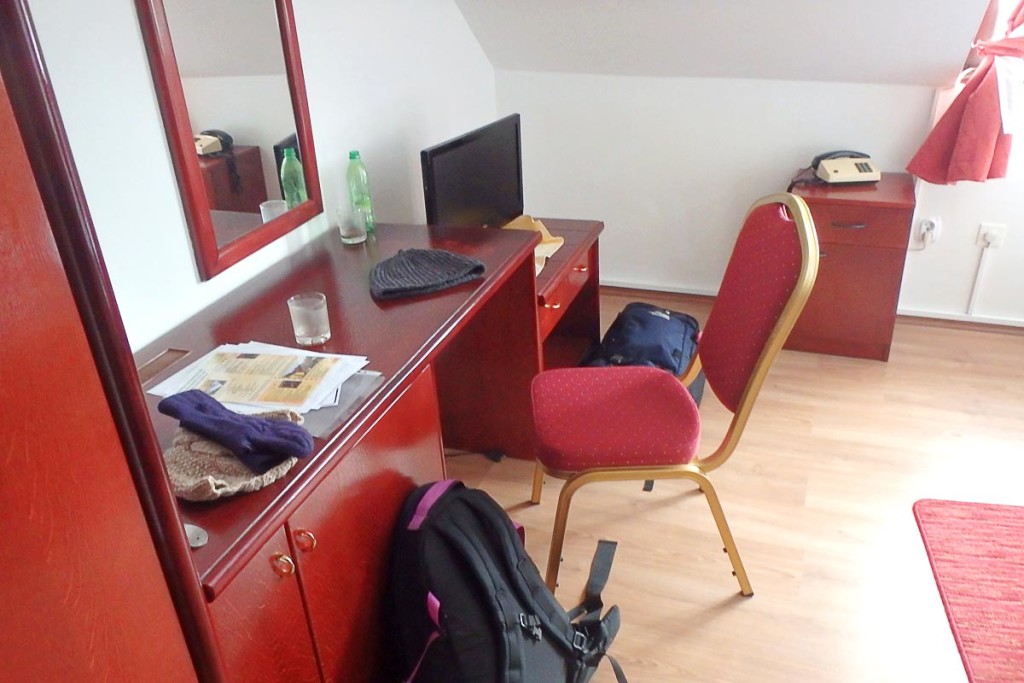
Garestin Pansion.
- Garestin Pansion, Varaždin – A larger hotel-type place, but not expensive. Nice breakfast buffet and some good dinner food in the restaurant (the gnocchi made my blood sugar pretty high though.) Easy access to both the bus station and the train station.
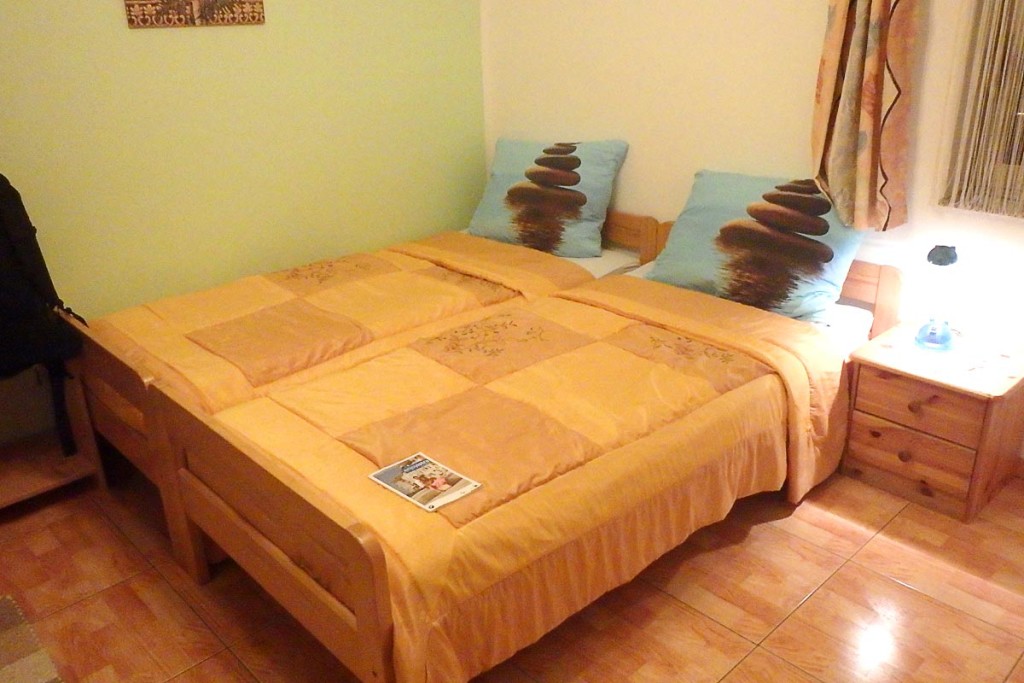
Apartman Ljiljani.
- Apartman Ljiljani, Pula – Very quiet little place amid the residences near a traffic roundabout with a small kitchen and a nice view over Pula. Close enough to walk to the train station and to the heart of Pula and the amphitheater. Nice, clean, simple, and cozy, if not sparkling and brand-new.
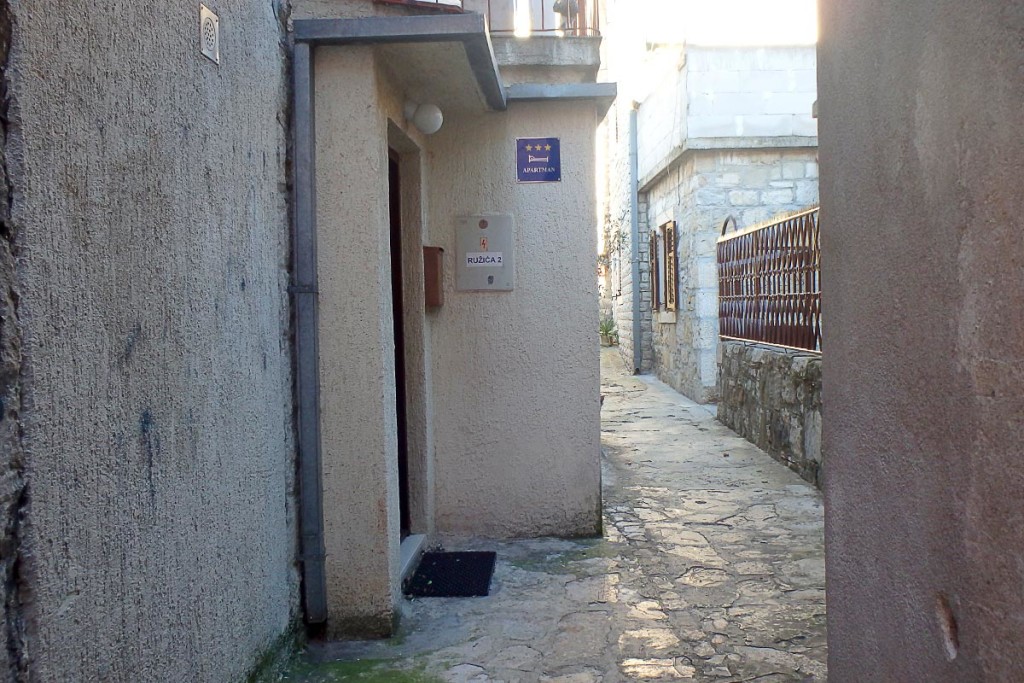
The charming alleyway to Viking House in Split.
- Viking House, Split – Amazing little place quite near the main waterfront area of Split, but quiet and super cozy. In what look like ancient houses, this place had a little kitchen and an excellent setting. A bit small, but you’ll be out in town all day so it’s fine.
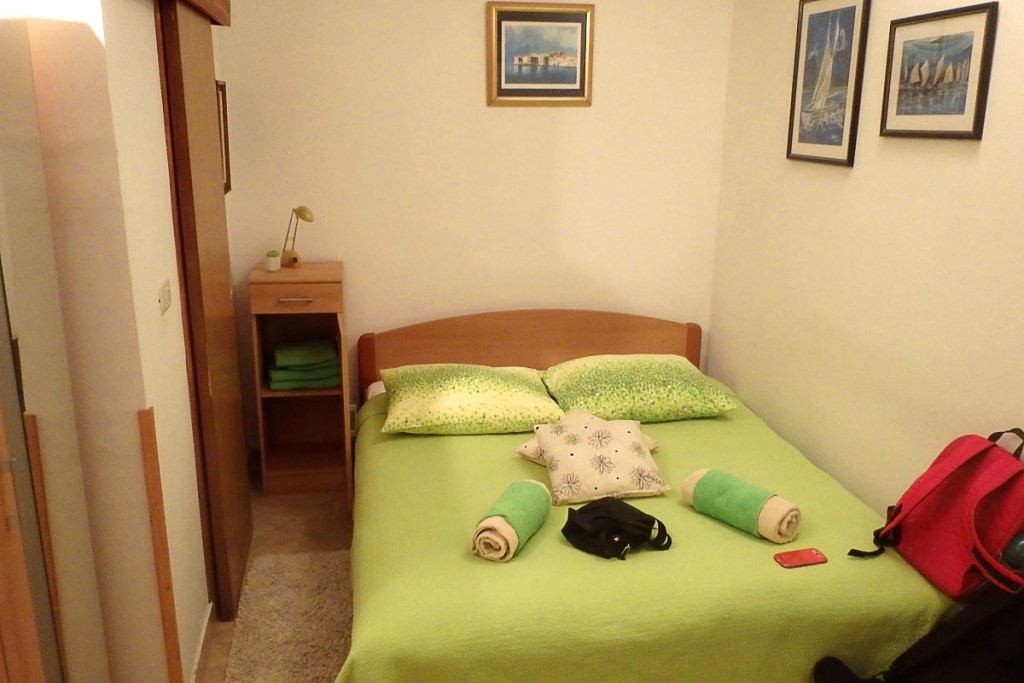
Guest House Tomasi.
- Guest House Tomasi, Dubrovnik – It’s hard to go wrong with any place in the middle of Old Town Dubrovnik. Up one of the steep stairways that spider out from the main streets, this was a rather small room with a simple kitchen. But while the room itself was fairly boring, the location was so good that it made absolutely no difference. Ultra-simple, with everything almost literally right outside the door.
Going to Croatia?
If you’ve been to Croatia, especially as a diabetic or with a fellow traveler who has diabetes, I’d love to hear about your own experiences in this complex and attractive country.
If you’re thinking of visiting Croatia and have any comment or questions about traveling there with diabetes, please let me know and I’ll do my best for you.
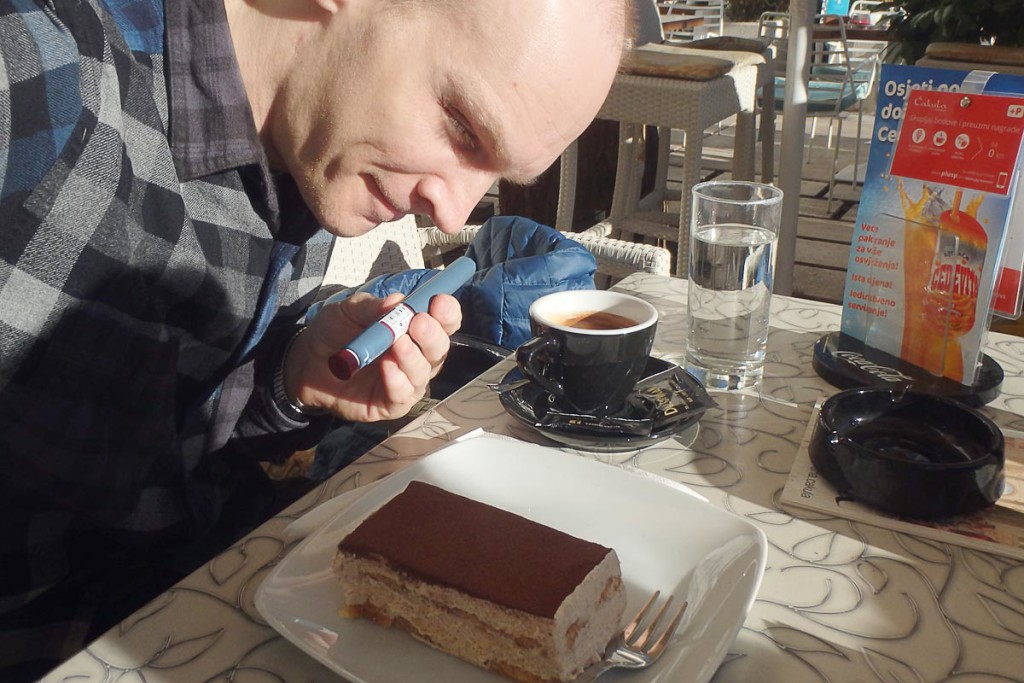
Insulin vs. tiramisu in Split: even if you calculate wrong, what a life!
Just remember to have a good, positive attitude about diabetes and do a little simple preparation. You can go anywhere with diabetes!
Read more about my travels in Croatia
Come along on the adventure! Follow detailed travelogues about the wondrous sights, fascinating people, and varied diabetes experiences I encountered as a traveling T1D in Croatia:
Day 69: Big Bus Out Of The Schengen Area To Zagreb, Croatia
Day 70: Strange Christmas Eve In Zagreb, Croatia
Day 71: Sunny Christmas In Zagreb, Croatia But Everything's Closed
Day 72: Delightful Little Osijek In Eastern Croatia
Day 73: Why Osijek, Croatia Is Still Scarred With Bullet Holes
Day 74: Scenic Snowy Train Journey To Varaždin, Croatia
Day 75: Trakošćan Castle, Croatia's Amazing Hard-to-reach Destination
Day 76: Long-distance Bus To Frigid Little Pula, Croatia
Day 77: A Long New Year's Eve In Pula, Croatia
Day 78: Sunny And Cold Roman Amphitheater In Pula, Croatia
Day 79: Scenic Bus Trip Along The Coast Of Croatia To Split
Day 80: Split And Diocletian's Underground Palace In Southern Croatia
Day 81: Day Trip To Trogir Castle In Southern Croatia
Day 82: Driving A Rental Car To The Lakes Of Imotski, Croatia
Day 83: Over The Border By Bus To Mostar In Bosnia And Herzegovina
Day 120: Jewel To Jewel: Bus From Kotor To Dubrovnik, Croatia
Day 121: Hiking Up Mount Srđ Above Dubrovnik, Croatia
Day 122: Leisurely Day Wandering Old Town Dubrovnik, Croatia
Day 123: A Walk Around The Top Of Dubrovnik's Old Town Walls
Day 124: The Ol' Dubrovnik To Trondheim, Norway Flight
Thanks for reading. Suggested:
- Share:
- Read next: Tips for traveling to Bosnia and Herzegovina with diabetes
- News: Newsletter (posted for free on Patreon every week)
- Support: Patreon (watch extended, ad-free videos and get other perks)

Support independent travel content
You can support my work via Patreon. Get early links to new videos, shout-outs in my videos, and other perks for as little as $1/month.
Your support helps me make more videos and bring you travels from interesting and lesser-known places. Join us! See details, perks, and support tiers at patreon.com/t1dwanderer. Thanks!

Jeremy, great post. Very uplifting. You make it seem easy. I am going to live in Split, Croatia for 3 months later this year and have a few questions. Did you have prescriptions from your US doctor for insulin? Did those work at a local pharmacy or did you need to see a Croat Doctor? Is the insulin in different concentrations than the US? (I called Novo Nordisk and they said only flex pens of insulin were in Croatia, no vials of insulin). Thanks for your help
Thanks Pam.
I didn’t live there, just passing through, so I carried the insulin I needed with me. I only had a doctor’s note explaining what I was traveling with for border security purposes, not for getting new supplies. I assume that like most places you do need a prescription from a doctor for insulin – but if you’re really hard up a pharmacy might get you some anyway (as happened to me in Norway, and as I was able to do with some thyroid pills in Zagreb).
I think you’ll be fine either way; explaining to a Croatian doctor in English that you need insulin would be a pretty mundane and everyday thing. And it will be fun to figure it out 😉
Have fun in Split, what a place to be able to live. Let me know what happens there!
Hi we are in pula right now myself and my daughter are type 1. Is there anywhere to buy sugar substitute like sugar twin. Kinda been looking but even at cafes nothing seems available. Thanks so much.
Valentina
Valentina,
To be honest I don’t use it so I’m not sure about its availability there. Google translate says that “sugar substitute” is “zamjena Å¡ećera” (pronounced “zom yay nah sheh chair uh”) but that may not help all that much. (You could try it.)
Good luck, let me know if you find it. How is Pula otherwise?? Amazing place!